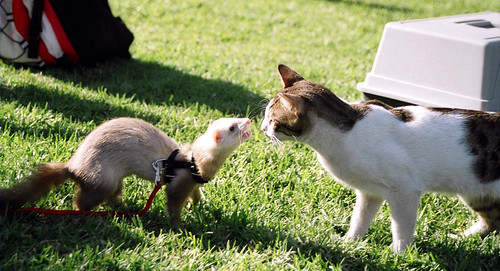
***DON'Ts are things that may injure your ferret, render discipline ineffective, or damage your relationship with your ferret. In other words: to foster a happy and fulfilling realtionship with your ferret, don'ts should be avoided AT ALL COSTS!
DO keep in mind that every ferret reacts differently to different forms of discipline - what works on one may not necessarily work on another; it is best to try multiple approaches until you figure out what works for your ferret.
DON'T nose flick!!! Besides being mean (a ferret's nose is very sensitive) and teaching your ferret that people are something to fear, nose flicking can lead to permanent damage of the nasal cavity.
DON'T spank, smack or hit your ferret in any way!!! These forms of 'discipline' border on abuse and tend to lead to less than friendly relations between ferrets and their owners. Remember: ferrets are SMALL ANIMALS - what may seem like a light tap on the bottom to you is in fact a jarring full body blow to a ferret. You wouldn't appreciate a large hockey player body checking you every time that you did something wrong, so why replicate the feeling by smacking your pet?

DO use time outs. They can give you and your pet a brief cool-down period.
DON'T use the cage as a time-out room. Doing so will cause your ferret to associate his cage with punishment and will leave him wondering what he did wrong come bedtime!
DON'T give more than 5 minute time outs. Any more than 5 minutes and your ferret will forget why he or she is IN time out, making the time out pointless.
DO try squirting the ferret with a spray of water for misbehaving. I find this one effective for deterring unwanted carpet and couch digging/ scratching for both ferrets AND cats.
DO use a firm "NO" to let your ferret know when he or she is doing something bad. I recommend using the firm "NO" before a time out, or in conjunction with a spray or a scruff, though it can be effective on its own.
DON'T yell at your ferret!!! You may frighten your ferret, and a ferret that considers humans to be a source of fear is not a happy ferret.
DO scruff your ferret and say "no". A gentle scruff and drag can also be effective for curbing nipping and other unwanted behaviour some in ferrets.
DO use praise to reinforce good behaviour. Positive re-enforcement is always a good thing, and the odd treat along the way certainly doesn't hurt.

DO pay attention to how your ferret reacts to different forms of discipline to determine what is effective for your ferret. At the moment, I have one ferret that reacts negatively to the "scruff and drag" but responds well to time outs and the firm "no". I have another ferret that responds to praise, but ignores the firm "no" and is impervious to time outs (he cannot be scruffed due to injuries sustained in his previous home).
Good luck figuring out what works for your ferret, and avoid DON'Ts like the plague!!!








